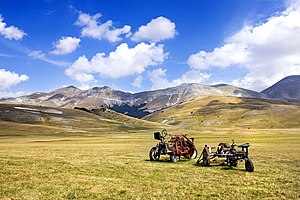

The Sibillini Mountains, or Sibylline Mountains (Italian: Monti Sibillini) are one of the major mountain groups in the Italian Peninsula, and part of the Apennines range. Most of the peaks are over 2,000 m (6,600 ft); the highest is Monte Vettore at 2,476 m (8,123 ft).
Since 1993 the area has been part of the Parco Nazionale dei Monti Sibillini (Sibillini Mountains National Park).
The present-day landscape morphology, predominantly U-shaped valleys and glacial depressions, is due to the action of glaciers during the Quaternary period.
The name Sibylline goes back to a legend about a cave in the mountains (today known as the Sibyl cave), where a male oracle and necromancer took refuge to escape Christian persecutions against paganism[citation needed] in the late Roman period, and who occasionally revealed secrets of the future. Necromancers and knights travelled from across Europe, after exhausting journeys, to try to obtain a prophesy.
Wildlife and vegetation
The small Lago di Pilato within a deep U-shaped valley below Monte Vettore, is home to a crustacean endemic to this location, Chirocephalus marchesonii.
The area contains stands of beech scattered amongst open subalpine grasslands and meadows maintained by the grazing of sheep.
See also
Sources
- Gentili, Bernardino (April 2002). "Note di Geomorfologia del Parco Nazionale dei Monti Sibillini". Collana dei Quaderni scientifico-divulgativi del Parco Nazionale dei Monti Sibillini. Ancona: Aniballi Grafiche.








